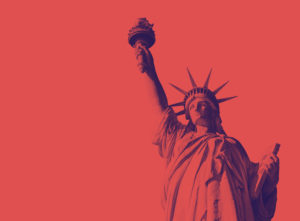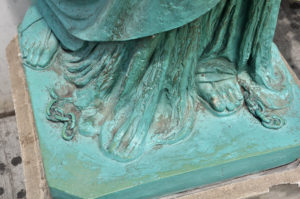
“Liminal” is defined as the space between. It is the no-longer before, and the not-yet other. It is the space where we find ourselves caught between the light of Juneteenth and the shadow of July 4th. We are caught in the space between. No longer enslaved on plantations, but not yet with a freedom fully realized. It’s an imaginative space; an emergent space; and a space for reflection.
It is in this space that I am reminded of the Statue of Liberty, and the broken chains at her feet. I first learned about the chains in 2017, at a training in Chicago led by Dr. Joy DeGruy. She told the story of how the chains were part of the original vision of the statue, how American financiers insisted that the chains be removed, and how the sculptor still managed to sneak the chains in under Lady Liberty’s garments, lying broken at her feet. She told the story how the National Park Services didn’t talk about the chains unless someone happened to ask. The chains were not part of the Park Services’ narrative about the Statue. In the Statue’s 135-year history, information about the chains have only officially been included in the park service’s literature and website for about the past six years.

Yasmin Sabina Khan goes even deeper in her work, “Enlightening the World: The Creation of the Statue of Liberty.” Conceived in 1865 by Édouard de Laboulaye, sculpted by Frédéric-Auguste Bartholdi over the course of approximately 20 years, the Statue of Liberty was unveiled at New York’s Ellis Island as “Liberty Enlightening the World” in October of 1886. At the base of the Statue, out of view from anyone looking from ground level, lie the broken chains of slavery. Visible only from helicopter or drone, the chains weren’t spoken of. Laboulaye was an ardent abolitionist. With the end of the US Civil War in 1865, Laboulaye imagined a gift that would embody the significance of the liberation of those who were enslaved. Bartholdi’s original model placed the torch of liberty in one hand, and broken chains in the other. The Statue of Liberty’s entire visual and artistic vocabulary was meant to both celebrate and honor the freedom of those enslaved in America. But financiers balked at the idea of chains placed anywhere on the Statue, and after profuse opposition by Bartholdi, the chains were removed, replaced by a tablet emblazoned with the Roman numerals for July 4, 1776. Since they aren’t easily visible, and since there was no concerted public effort to connect the statue with the narrative of the abolition of chattel slavery, the memory of it’s connections faded. And for the past 135 years, barely anyone remembered the chains.
For Black people within this liminal march of history, the Statue has long sat as a symbol of hypocrisy—celebrating a freedom that became connected to a honoring of ideals that have yet to be realized. There’s much to unpack about our historical reactions to the unveiling of the Statue, but there’s also much to be said about the loss of memory. The obscuring and loss of communal memory around the presence, history, and meaning of the chains at the feet of the Statue of Liberty is important because it reminds us that memory is important. And not only is memory important, memory is crucial in this liminal space between freedom and freedom. Memory is what helps us imagine. Memory is what helps us create. It’s something we can use to construct and define a new world, a new freedom, a new way of being. We must tap into it.
In his book, “Something Torn and New: An African Renaissance” Ngugi wa Thiong’o writes, “creative imagination is one of the greatest of re-membering practices…” and that “memory is the link between the past and the present, between space and time, and it is the base of our dreams.” Harnessing memory is our work. These broken chains at our feet, the light of Juneteenth, the long shadow of July 4th—this liminal space—all of it is here to remind us that we have worlds to build. We have a freedom to define—to make clear and meaningful. It is within this creative tension where we have the possibility to gain a clear-eyed view of what a full realization of freedom could look like, both collectively as a community and a country, and particularly in the living out of our individual lives and individual situations. But understand, there can be no clear expression of freedom without integrating communal memory into the foundation of work.
If memory is the base of our dreams, what are our dreams of freedom? What if we could transform freedom in the same ways that we’ve always transformed culture? In this liminal space of history, we’ve seen Black creativity, Black genius, Black art, and Black joy shift and drive culture (and economies) around the world. Have we fired that same ingenuity in our definitions of freedom? What would the world look like, if we defined and constructed freedom based on our criteria, our imaginations, our memory? It might look something like a society built on the idea of thriving rather than destruction. It might look something like a society built around dignity—of humans, animals, and the earth. It might look something like systems built to nourish and sustain life rather than profit. Freedom could look like so many different visions of more and better. The dreaming is up to us.
We have work to do. We have worlds to build. We have a freedom to create. And as we go about protesting and advocating for our lives, here in this liminal space between freedom that was and freedom that might yet be, may we remember that the work we have to do, the worlds we are building, and the freedom we are creating, cannot reach their fullest expression without our communal memory.
Let us remember the chains broken at our feet, so that we may creatively continue in our generation’s leg of the journey toward the light of freedom fully realized.

We have marched and advocated for freedom from dozens of legalized lynchings at the hands of police with mixed success. Will we fight for freedom from thousands of street shootings of blacks by young black men?